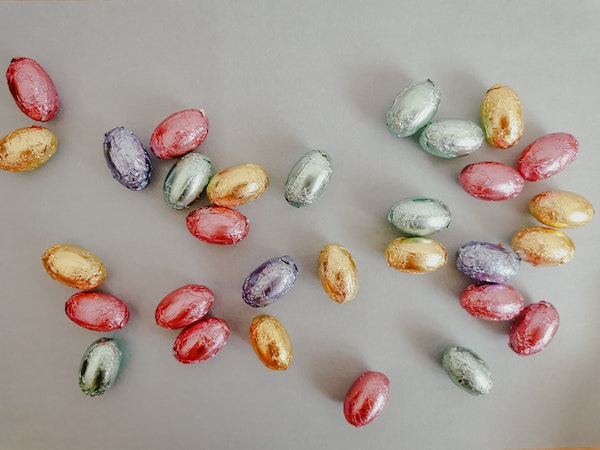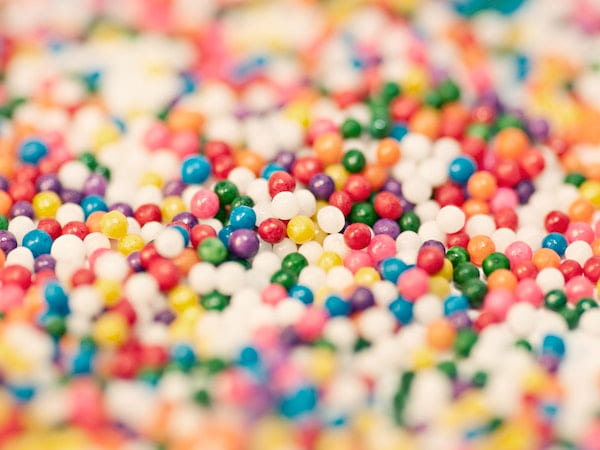There are many ways to add color to a model, wall, furniture, or art piece. You can use various paint types in different color shades and finish with varnish, lacquer, or other unique sealants. But there’s another stunning aspect to painting that’s not so popular: adding decorative chips to paint.
If you have seen decorative chips added to a garage floor or wall, you may wonder, can you put decorative chips in latex paint? This is especially true since latex is one of the most popular water-based paints used in various projects.
The answer is yes, you can use decorative chips in latex paint, and contrary to popular perception, it will not cause the paint to chip or peel. In this blog post, we will talk about using decorative chips in latex paint, defining what they are, and how to use them in your painting.
Can You Put Decorative Chips in Latex Paint
We recommend using decorative chips to add some pizzazz to your surfaces, walls, or garage floor. Decorative chips also help enhance paint texture and bring out the color hues, giving it a more aesthetic appeal. However, it’s best to follow proven step-by-step guidelines to achieve the most stunning results.
What are Decorative Chips, and How are They Used?
Decorative chips are colored flecks or forms of formulated vinyl paint aggregates used to create beautiful art finishes.
Also known as paint chips or color flakes, these decorative pieces are typically used in resinous floor coatings to enhance the floors’ aesthetic appeal and improve texture, paint thickness, and overall ergonomic quality.
Paint chips are also great for hiding surface imperfections as well as acting as an aggregate to reduce surface slipperiness.
You can achieve different texture levels with decorative chips, and they’re also available in various color options and sizes, which you can blend into a custom design. Furthermore, using paint chips comes with unlimited benefits.
They’re primarily made from acrylic and vinyl resins, which makes them impressively durable, especially when applied on commercial-grade coatings. They can create a unique aesthetic appeal as color combos are customizable. They are also safe to use on most surfaces and resist slips and falls.
In addition, color chips help suppress noise from vehicles or foot traffic, especially if used on garage floors. Finally, since color chips are typically top-coated with a clear coat or a UV-stabilized epoxy, cleaning is relatively easy, and longevity in outdoor environments is guaranteed.
What to Know Before You Put Decorative Chips in Latex
Below are a few basic pointers for adding decorative chips to latex paint.
Choose the Best Decorative Chips
You can enhance the outcome of your latex paint by adding decorative chips. However, since these chips come in various sizes and color combos, consider the following factors when making your choice.
Select the best material: color flakes can be made from glass, plastic, or metal. Choose the material that meets the desired weight and longevity of your paint project.
Ensure you have the correct size: Decorative chips are usually available in various sizes ranging from large shards to small flecks. Larger surface coverages require more chips and vice versa, so get the size right.
Color: Choose the color shade that matches your latex paint to create a unique color combo.
Texture: Color chips can be smooth or rough, so the texture you choose should go with the desired look of your finished project. If you want a more uniform appearance, go for smooth chips. For a better visual effect, a rougher texture option will do.
Prepare the surface and ensure safety
The next factor to consider once you have chosen your color chips is surface preparation and safety. Ensure the space is free of objects or furniture, and if you’re painting a model, cover the floor with a drop cloth to trap paint spills.
If painting a wall, remove debris, dust, or loose paint. It’s best also to ensure the place is well-ventilated for unlimited air circulation.
Once you’ve taken the necessary safety precautions, gather everything you’ll need, such as the latex paint, decorative chips, brushes, rollers or paint sprayer, and protective gear (gloves, mask, and goggles).
How to Professionally Put Decorative Chips in Latex Paint
Follow these steps to add decorative chips to your latex paint.
Step 1: Clean the surface for painting
The first step in painting always involves surface cleaning to remove loose latex paint, accumulated dust, and visible debris.
Use the appropriate cleaner to remove all contaminants, then leave to dry. You can lightly sand the surface to roughen it to ensure maximum grip. If sanding is not necessary, add a primer.
Step 2: Mix different colors of latex paint
Depending on the color theme you want to create, you can mix your different types of latex paint to achieve a uniform color combo. If the desired color is standard, you can still mix the paint to ensure all the pigments and solvents are thoroughly blended.
For this, use a paint stirrer to create a uniform consistency that will result in a stunning application.
Step 3: Apply Paint
With the paint ready, you can apply it by brushing or spraying. Spraying is easier, faster, and the best technique we recommend is using HVLP sprayer for latex paints. However, depending on your project, you can use a brush or, if working on a wall or floor, a roller.
Step 4: Sprinkle the Chips
Once you’ve covered the surface with the required number of paint coats, it’s time to sprinkle the decorative chips over the latex. Take a handful of chips at a time and sprinkle them evenly over the surface.
Start with a small amount, then gradually add more until you achieve the desired effect. You can experiment with color chips of varying sizes and colors to see which ones have the best effects or mix them up to achieve unique patterns.

Step 5: Press the chips on the paint
Your decorative chips must be pressed onto the paint to stick and provide optimal results. Use a roller to gently press the chips onto the paint until firmly embedded.
Step 6: Leave to Dry
It would be best to let the painted surface and chips dry completely by allowing enough drying time. This time can be a few hours to a day, depending on the weather and temperature. This will ensure that the paint and the chips adhere firmly to each other and the substrate.
Step 7: Protect with a floor coating system or sealant
This step is optional and entirely up to you, but it’s best to seal the surface with a clear topcoat. Sealing is good for maintaining durability and protecting against moisture, wear, and tear.
It also ensures the surface retains a smooth, polished look. For best results, follow the instructions on the label of the sealant.
Do I Need a Primer for Latex Paint Chips?
This depends on the type of surface you’re painting. Latex paint offers excellent adhesion, but priming can be necessary depending on the project.
Therefore a good quality primer specifically designed for latex paint is essential to ensure that the paint and color chips will bind optimally.
If you’re unsure which primer to choose, we recommend Rust-Oleum Painter’s Touch Latex Primer and Rust-Oleum Zinsser Bulls-Eye 1-2-3 Plus Spray Primer, as they’re some of the best choices for latex paint.
Do Latex Paint Chips Work on Garage Floors?
Absolutely. Most latex paint chips are compatible with garage floors and only require thorough surface preparation to be effective. If the floor doesn’t have cracks or other forms of damage, your paint chips could stick without issues.
The main factor will be the paint used. It’s best to work with latex concrete paints for floors instead of regular latex paint.
Also, ensure you follow the directions on the paint container as specified by the manufacturer; otherwise, poor application will affect the outcome on the concrete floor.
FAQS: How to Add decorative Chips in Latex
Does latex paint chip off?
It is rare for newly applied latex paint to chip off. However, this can happen due to a number of reasons. For example, using the wrong technique to apply paint, not cleaning and preparing the surface, or using the wrong paint type. You should also avoid applying latex over oil-based paint as it will chip off within a few hours of application.
How do you use decorative paint chips?
To use decorative chips on latex paint, spray paint on a carefully prepared surface and ensure good priming for better grip. Then with the paint still wet, sprinkle decorative chips of various sizes and colors for a more personalized effect. Press the chips on the paint until fully embedded, then allow to dry.
What are paint chips for?
Paint chips are used to add beauty to a newly painted surface. They help improve the texture and appearance of your paint job. They also support paint thickness and overall ergonomic quality. You can add paint chips to conceal surface imperfections and prevent slips and falls by reducing surface slipperiness since chips act as an aggregate.
Are decorative chips the same as paint flakes
Yes. Decorative chips and paint flakes are used interchangeably to refer to small pieces of decorative paint flecks. They’re typically made from formulated vinyl paint aggregates. They are also known by other terms, such as color flakes or colored flecks, to refer to these decorative art pieces for beautifying epoxy and resin finishes.
How do you use Rust-Oleum decorative color chips?
For every 100 square feet of surface area, distribute a half pound of decorative vinyl paint chips over the wet paint in an underarm manner. Start with a moderate amount of chips, then gradually increase as desired. Embed the chips by pressing them and leaving them to dry overnight. Seal with a clear coat once the paint and chips have dried.
Conclusion: Decorative chips in Latex Paint
One way to explore your creative side with latex paint is to use decorative paint chips in your painting. It’s an opportunity to open up a world of creative possibilities where you experiment with different ideas to achieve a unique effect.
However, when starting, it’s best to work with a manual or set of guidelines to ensure you get everything right with the first trial.
Now that you’ve established that you can embed decorative chips in latex paint, it’s time to experiment with different color chips and compare the versatility and aesthetic appeal to other techniques. Use your creative imagination to paint custom, beautiful surfaces.

